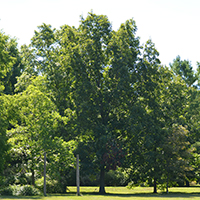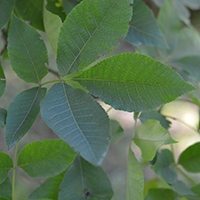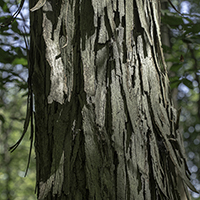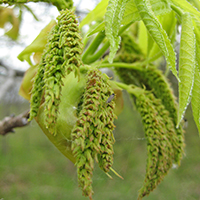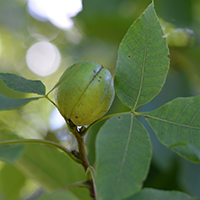What shagbark hickory looks like
Size and shape
- Reaches 20 to 30 metres tall.
- Trunk reaches 30 to 80 centimetres in diameter.
Leaves
- Have 5 leaflets on a central stalk (15 to 25 centimetres long).
- Green on top and pale and hairy underneath.
Bark
- Separates into long plates as the tree ages, which loosen from the trunk and make the tree look shaggy.
Flower
- Clusters of green catkins (10 to 15 centimetres long) (male) and tiny clusters of 2 to 4 spikes at the tip of the current year's new branchlets (female).
Fruit
- Edible round nuts (3 to 4.5 centimetres long).
Where shagbark hickory is found
Shagbark hickory grows in Southern Ontario, including along the St. Lawrence River and into Quebec.
What you need to know to grow shagbark hickory
- Moisture: grows best in moist soil.
- Shade: grows best in sun but can tolerate some shade.
- Soil: grows best in rich soil.
- Note: shagbark hickory grows well on hillsides and in valleys where soil is moist.
Benefits and uses of shagbark hickory
Wildlife benefits
Sweet tasting shagbark hickory nuts are a favourite food of squirrels. A variety of other mammals and birds eat shagbark hickory nuts, including chipmunks and black bears.
Commercial uses
Shagbark hickory has strong wood that can be used to make durable and shock resistant products, such as flooring, tool handles, sporting equipment, and furniture. It is a long-burning wood that can also be used as fuel or charcoal for a hickory flavour in cooking.
Fun facts about shagbark hickory
- Shagbark hickory gets its name from its shaggy bark.
- Shagbark hickory trees can live for 200 years.
- Lone stands of shagbark hickory have been found near Lake Huron and Georgian Bay. These trees may have been planted by Indigenous peoples hundreds of years ago.
Updated: January 10, 2024
Published: July 18, 2014
